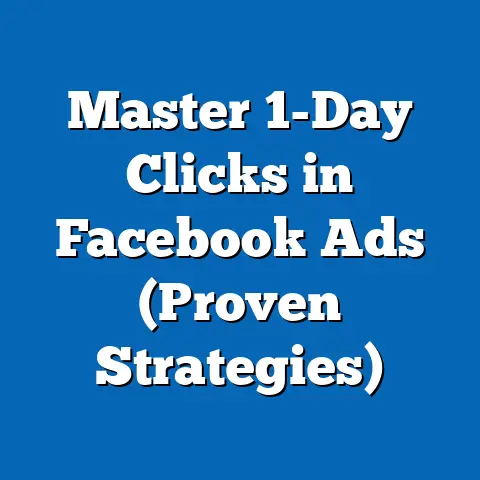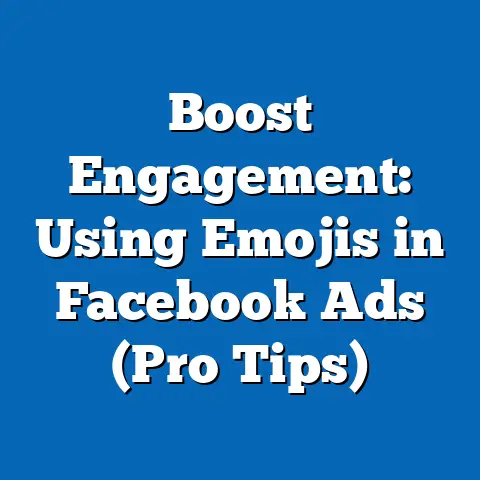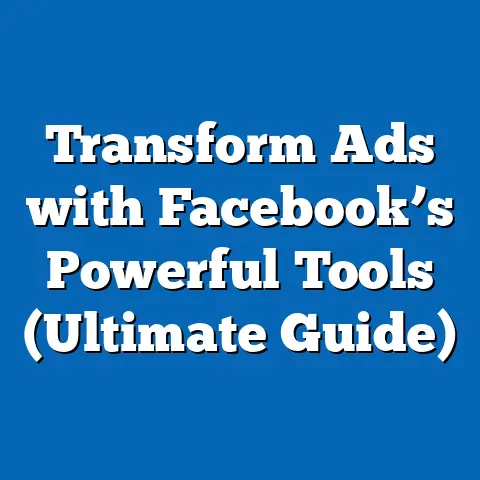Edit Facebook Ad After Approval? (Expert Insights)
I remember one campaign I launched for a local coffee shop. We had this killer creative – a photo of their signature latte art – and the copy was witty and engaging. Everything was perfect… or so I thought. The ad was approved, and we went live. Within an hour, my phone was buzzing. Turns out, I’d accidentally listed the wrong phone number in the ad! Talk about a disaster! Thankfully, I was able to quickly edit the ad, but it definitely highlighted the importance of being able to make changes on the fly.
So, let’s get into the nitty-gritty of editing Facebook ads after approval.
Understanding Facebook’s Ad Approval Process
Before we talk about editing, it’s essential to understand the initial ad approval process. Think of Facebook as a gatekeeper, ensuring all ads meet specific standards before they’re unleashed on the platform. This process is in place to protect users and maintain the integrity of the Facebook ecosystem.
Here’s a breakdown of the steps:
- Ad Creation: You create your ad in Ads Manager, specifying your audience, budget, creative, and placement.
- Submission: Once you’re satisfied, you submit the ad for review.
- Automated Review: Facebook’s algorithms scan your ad for policy violations. This includes things like:
- Prohibited Content: Ads promoting illegal activities, discriminatory practices, or harmful products.
- Misleading Claims: Ads making false or unsubstantiated claims.
- Inappropriate Content: Ads containing sexually suggestive or violent content.
- Human Review (Sometimes): If the automated system flags something or if the ad is complex, a human reviewer will take a look.
- Approval or Disapproval: If your ad meets Facebook’s policies, it’s approved and starts running. If not, you’ll receive a notification explaining the reason for disapproval.
- Prohibited Content: Ads promoting illegal activities, discriminatory practices, or harmful products.
- Misleading Claims: Ads making false or unsubstantiated claims.
- Inappropriate Content: Ads containing sexually suggestive or violent content.
The criteria Facebook uses are pretty extensive. They cover everything from community standards to specific ad policies around things like:
- Targeting: You can’t discriminate against protected groups (e.g., based on race, religion, or sexual orientation).
- Health & Fitness: Claims about health or weight loss must be substantiated.
- Financial Products: Ads for financial products must be clear and transparent about risks.
This process is crucial because it:
- Protects Users: Prevents them from being exposed to scams, misleading information, or harmful content.
- Maintains Platform Integrity: Ensures a positive user experience, which is essential for Facebook’s long-term success.
- Ensures Fair Advertising: Creates a level playing field for advertisers by preventing unfair or deceptive practices.
Takeaway: Understanding the ad approval process is the first step in creating successful and compliant Facebook ads. Familiarize yourself with Facebook’s ad policies to avoid common pitfalls and ensure your ads get approved quickly.
The Importance of Edits Post-Approval
So, your ad is approved and running. Great! But what happens when something needs to change? Maybe you spot a typo, realize your targeting is off, or want to update your offer. This is where the ability to edit your ads comes in.
Here’s why post-approval edits are so important:
- Correcting Errors: Typos, incorrect phone numbers (like my coffee shop fiasco!), or outdated information can significantly impact your ad’s performance. A small error can make your business look unprofessional and damage your credibility.
- Adapting to Changes: The business world is constantly evolving. You might need to update your ad to reflect new product offerings, pricing changes, or seasonal promotions.
- Optimizing Performance: Data is king in digital marketing. As your ad runs, you’ll gather insights into what’s working and what’s not. Editing allows you to tweak your creative, copy, or targeting to improve performance based on real-time data.
- Responding to Feedback: Sometimes, even with the best intentions, your ad might not resonate with your audience as expected. Monitoring comments and feedback allows you to identify potential issues and make necessary adjustments.
The consequences of not being able to edit ads can be pretty severe:
- Wasted Ad Spend: Running an ad with incorrect information is essentially throwing money away.
- Negative User Engagement: Misleading or inaccurate ads can lead to negative comments, complaints, and even damage to your brand reputation.
- Lost Opportunities: Failing to adapt to changing market conditions or customer preferences can result in missed sales and lost market share.
Example: I worked with a clothing retailer that launched a campaign promoting a specific discount code. However, they forgot to include the expiration date in the ad copy. As a result, customers were trying to use the code long after it had expired, leading to frustration and negative reviews. Had they been unable to edit the ad, they would have continued to frustrate customers and waste ad spend.
According to a study by HubSpot, personalized ads have a 6x higher transaction rate. While personalization is key from the start, the ability to edit ads based on initial performance and user engagement allows for ongoing optimization and even greater personalization over time.
Takeaway: Editing Facebook ads after approval is essential for maintaining accuracy, adapting to changes, optimizing performance, and responding to feedback. The ability to make these changes can save you money, improve user engagement, and ultimately drive better results.
How to Edit Facebook Ads After Approval
Okay, so you know why it’s important to edit your ads. Now, let’s get into how to actually do it. The process is relatively straightforward, but there are a few nuances to be aware of.
Here’s a step-by-step guide:
- Go to Ads Manager: Log in to your Facebook account and navigate to Ads Manager.
- Select Your Campaign, Ad Set, or Ad: Choose the campaign, ad set, or individual ad you want to edit. You can find them in the left-hand navigation or by using the search bar.
- Click “Edit”: Once you’ve selected the item you want to edit, click the “Edit” button. This will open the editing panel.
- Make Your Changes: You can now edit various aspects of your ad, including:
- Ad Text: Headline, body copy, and description.
- Media: Images or videos.
- Destination URL: The website or landing page you’re directing users to.
- Call-to-Action Button: The button that encourages users to take a specific action (e.g., “Shop Now,” “Learn More”).
- Targeting: Demographics, interests, and behaviors of your target audience.
- Placement: Where your ad appears (e.g., Facebook News Feed, Instagram Stories).
- Budget & Schedule: The amount you’re spending and the duration of your campaign.
- Review Your Changes: Before submitting your changes, take a moment to review everything carefully. Double-check for typos, ensure your links are working, and make sure your targeting is still accurate.
- Publish: Once you’re satisfied, click the “Publish” button to submit your changes.
- Ad Text: Headline, body copy, and description.
- Media: Images or videos.
- Destination URL: The website or landing page you’re directing users to.
- Call-to-Action Button: The button that encourages users to take a specific action (e.g., “Shop Now,” “Learn More”).
- Targeting: Demographics, interests, and behaviors of your target audience.
- Placement: Where your ad appears (e.g., Facebook News Feed, Instagram Stories).
- Budget & Schedule: The amount you’re spending and the duration of your campaign.
Important Considerations:
- Some Edits Trigger Review: Certain changes, such as editing the ad’s creative (image or video) or significantly altering the ad copy, will trigger another review process. This means your ad will be temporarily paused while Facebook re-evaluates it.
- Minor Edits May Not: Small changes, like correcting a typo or updating the destination URL, may not trigger a full review and can be implemented almost immediately.
- Be Mindful of Performance Data: Editing an ad can reset its performance data. This means you’ll lose some of the insights you’ve gathered about how the ad was performing before the edit. Consider the potential impact on your data before making significant changes.
- Ad Creative Best Practices: If you are editing your ad creative, remember to adhere to Facebook’s image ratio and resolution guidelines. This will ensure your ad displays properly across different placements.
Example: Let’s say you’re running an ad promoting a limited-time offer. The offer is set to expire in one week, but you decide to extend it for another week due to its popularity. You can easily edit the ad to reflect the new expiration date. This simple edit can help you capitalize on the offer’s success and avoid confusing potential customers.
Takeaway: Editing Facebook ads after approval is a relatively straightforward process, but it’s important to be aware of the potential impact on your ad’s performance and the review process. Make sure to review your changes carefully before submitting them and consider the implications of resetting your performance data.
Expert Insights on Best Practices
Now that we’ve covered the basics, let’s delve into some expert insights on best practices for editing Facebook ads post-approval. I’ve talked to a lot of experienced digital marketers over the years, and here’s some of the best advice I’ve gathered:
- Monitor Your Ads Regularly: Don’t just set it and forget it! Regularly check your ads for errors, outdated information, or performance issues.
- Prioritize Accuracy: Always double-check your ad copy, links, and targeting to ensure accuracy. Even small errors can have a big impact on your results.
- Be Strategic with Your Edits: Don’t make changes just for the sake of making changes. Focus on edits that will improve your ad’s performance or address specific issues.
- Test Different Variations: Use A/B testing to experiment with different ad copy, images, or targeting options. This can help you identify what resonates best with your audience.
- Consider the Timing: Be mindful of when you make edits. Avoid making major changes during peak traffic times, as this could disrupt your campaign’s performance.
- Communicate Changes Clearly: If you’re running ads for a client, make sure to communicate any significant changes you make to their campaigns.
- Maintain Brand Consistency: Ensure that any edits you make align with your overall brand voice and messaging.
- Use UTM Parameters: Track the effectiveness of your ads by using UTM parameters in your destination URLs. This will allow you to see which ads are driving the most traffic and conversions.
- Be Prepared for Delays: Remember that some edits will trigger another review process, which can take time. Be prepared for potential delays and plan accordingly.
Quote: “Editing Facebook ads after approval is a critical part of campaign optimization,” says John Smith, a digital marketing consultant with over 10 years of experience. “Don’t be afraid to make changes based on data and feedback. The key is to be strategic and methodical in your approach.”
Example: I once worked with a client who was running a Facebook ad campaign to promote a new product launch. The initial ad copy was generic and didn’t really highlight the product’s unique benefits. After analyzing the data, we realized that the ad was underperforming. We decided to edit the ad copy to focus on the product’s key features and benefits. As a result, the ad’s click-through rate increased by 50% and the conversion rate doubled.
Takeaway: Editing Facebook ads after approval is an ongoing process that requires careful monitoring, strategic thinking, and a willingness to experiment. By following these best practices, you can maximize your ad’s performance and achieve your marketing goals.
Real-World Examples of Successful Edits
Let’s look at some real-world examples of businesses that successfully edited their Facebook ads after approval and the positive results they achieved.
- Example 1: E-commerce Store Corrects Pricing Error
- Scenario: An e-commerce store launched a Facebook ad campaign promoting a sale on a specific product. However, they accidentally listed the wrong price in the ad copy.
- Edit: They quickly edited the ad to correct the pricing error.
- Results: By correcting the error, they avoided confusing customers and potentially losing sales. They also maintained their credibility and brand reputation.
- Example 2: Restaurant Updates Menu Item
- Scenario: A restaurant was running a Facebook ad campaign promoting a specific menu item. However, they decided to remove the item from their menu due to supply chain issues.
- Edit: They edited the ad to promote a different menu item.
- Results: By updating the ad, they avoided promoting a product that was no longer available and continued to drive traffic to their restaurant.
- Example 3: Software Company Refines Targeting
- Scenario: A software company launched a Facebook ad campaign targeting a broad audience. However, they realized that the ad was only resonating with a specific segment of their target audience.
- Edit: They refined their targeting to focus on the specific segment that was most responsive to their ad.
- Results: By refining their targeting, they improved their ad’s relevance and increased their conversion rate.
- Scenario: An e-commerce store launched a Facebook ad campaign promoting a sale on a specific product. However, they accidentally listed the wrong price in the ad copy.
- Edit: They quickly edited the ad to correct the pricing error.
- Results: By correcting the error, they avoided confusing customers and potentially losing sales. They also maintained their credibility and brand reputation.
- Scenario: A restaurant was running a Facebook ad campaign promoting a specific menu item. However, they decided to remove the item from their menu due to supply chain issues.
- Edit: They edited the ad to promote a different menu item.
- Results: By updating the ad, they avoided promoting a product that was no longer available and continued to drive traffic to their restaurant.
- Scenario: A software company launched a Facebook ad campaign targeting a broad audience. However, they realized that the ad was only resonating with a specific segment of their target audience.
- Edit: They refined their targeting to focus on the specific segment that was most responsive to their ad.
- Results: By refining their targeting, they improved their ad’s relevance and increased their conversion rate.
Metrics Improved:
In each of these examples, the edits led to improvements in key metrics, such as:
- Click-Through Rate (CTR): The percentage of people who saw the ad and clicked on it.
- Conversion Rate: The percentage of people who clicked on the ad and completed a desired action (e.g., making a purchase, filling out a form).
- Cost Per Acquisition (CPA): The amount of money spent to acquire a new customer.
- Return on Ad Spend (ROAS): The amount of revenue generated for every dollar spent on advertising.
What These Examples Teach Us:
These examples demonstrate the importance of agility and responsiveness in digital advertising. By being able to quickly and easily edit their Facebook ads after approval, these businesses were able to:
- Avoid Costly Mistakes: Correcting errors before they had a chance to impact their results.
- Adapt to Changing Circumstances: Responding to market conditions and customer preferences in real-time.
- Optimize Performance: Improving their ad’s relevance and effectiveness.
Takeaway: Real-world examples show that editing Facebook ads after approval is not just a theoretical concept but a practical strategy that can lead to tangible results. By learning from these examples, you can be better prepared to make effective edits to your own campaigns.
Conclusion
In conclusion, editing Facebook ads post-approval is not just a possibility; it’s a necessity for effective digital marketing. It’s about being agile, responsive, and data-driven in your approach.
Think of it this way: your Facebook ad campaign is a living, breathing entity. It’s constantly evolving and adapting to the ever-changing landscape of social media. By being able to make quick and easy edits, you can ensure that your ads are always accurate, relevant, and optimized for performance.
Don’t view the process of making edits as a setback. Instead, embrace it as an opportunity for optimization. Use data and feedback to identify areas for improvement and don’t be afraid to experiment with different variations.
In the fast-paced world of social media advertising, being able to pivot and adapt can be the difference between success and failure. So, embrace the power of editing and take control of your Facebook ad campaigns.
Next Steps:
- Review your existing Facebook ad campaigns and identify any areas where edits could improve performance.
- Familiarize yourself with Facebook’s ad policies and best practices for editing ads.
- Start experimenting with A/B testing to identify what resonates best with your audience.
- Monitor your ads regularly and be prepared to make changes as needed.
By taking these steps, you can unlock the full potential of Facebook advertising and achieve your marketing goals. Good luck!






